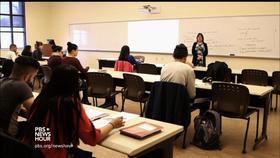Online education is becoming a prevalent option at institutions of higher education. More and more community colleges are offering students both on-site and online course choices to accommodate students’ busy schedules and geographical challenges. While online education might sound like a convenient option at first glance, this style of learning is not right for every student. Check out the pros and cons of online education before deciding whether distance learning will be the best fit for you.
Types of Online Education
Online education does not fit a single mold; there are many different models of distance learning utilized by community colleges today. Some of the various type of online education, listed at Campus Explore, include:
Asynchronous Learning
Asynchronous learning is a style that allows students to work at their own pace. Its primary popularity lies in its extreme flexibility; students do not have to follow a set schedule for lectures, homework assignments or other coursework. Material is generally distributed online and often includes audio or visual aids to bring the material to life. Students often have opportunities to interact with other students online, and assignments are typically delivered through an electronic bulletin board or similar format.
Synchronous Learning
Synchronous learning involves set times for class work, whether through physical classrooms, online chat rooms or video conferencing. Students have less flexibility with this type of learning environment, but they do have more opportunity for interaction with professors and other students. This type of learning may also be referred to as “fixed-time” courses, where students have to sign onto their computers at a set time each day to get the necessary material and information.
Hybrid Learning
Another popular style of online learning is a hybrid between asynchronous and synchronous classes. This model might vary substantially between classes, based on the preferences of the students and professor running the course. In some cases, students might be required to sign in for video conferencing and/or chat rooms once or twice a week, but homework assignments are still based on a flexible schedule. Others might allow students to explore material on their own time, but set dates for assignments and tests that must be adhered to without fail.
Academic Performance and Online Learning
Some students shy away from online learning because they are concerned their academic performance might suffer in this type of environment. While not every student is cut out for online learning, those that work well in an autonomous environment tend to thrive in online learning programs, based on recent studies. GetEducated.com reported on a study conducted by the U.S. Department of Education between 1996 and 2008, which showed that distance education is more effective than traditional learning.
The study examined 51 factors that directly impact learning effectiveness and found that additional communication options and time spent on learning were the two factors that had the most positive impact in online learning.
Inside Higher Ed also reported last spring that distance education enrollment was on the rise, suggesting that more students today are seeing the benefits of online learning than ever before. The report cited a nine-percent increase in enrollment between fall 2009 to fall 2010 for online learning at community colleges, which was higher than the increase at other institutions of higher education. As more students turn to online education, colleges may put their focus on these programs to ensure students do not sacrifice quality of education to enjoy more convenience and cost savings.
Pros of Online Education
There are a number of benefits to taking community college classes online, according to the Online College Education Network, including:
- There are no travel costs or time spent commuting to and from classes.
- Students enjoy great flexibility and can schedule classes and assignments around work and family responsibilities.
- Students are no longer limited by geographical location when selecting a school and degree program.
- Students who are disabled or have other reasons why they cannot attend classes regularly can get the same benefit at home.
- Material is delivered via the Internet, ensuring information is updated regularly.
- Students can work at their own pace, rather than trying to keep up with a group.
These benefits can be significant to students seeking a community college education – especially if they fit into some of the situations listed above. Online classes also offer a cost savings, allowing students to reap the benefits of an education without paying for transportation, housing or class materials. Despite the many pluses online education affords, there are some downsides to consider as well.
Drawbacks of Online Education
Some of the disadvantages to distance education might include:
- Students may not get questions answered by professors as promptly as they would in a classroom.
- Students must have plenty of self-discipline to keep up with assignments without a weekly schedule.
- Online education limits the amount of interaction students get with peers and faculty.
- Students may not have as many audio and visual resources to draw from when learning new material.
- Students must be very comfortable with technology to ensure the online system works properly for them.
These drawbacks, like the advantages should be carefully weighed when determining whether an online education is the best fit for you.
The bottom line, according to View on Education, is that online learning works best for students who are self-motivated, learn best through reading and writing, and have special interests they want to expand upon. Distance learning may not be the best choice for students who want ample peer and faculty interaction, who learn better through audio and visual aids, or who tend to procrastinate on assignments.
Distance learning works – for the right student. By taking an honest assessment of your own learning style, you can determine whether online education will present the best learning environment for you.
Questions? Contact us on Facebook @communitycollegereview.





















































































